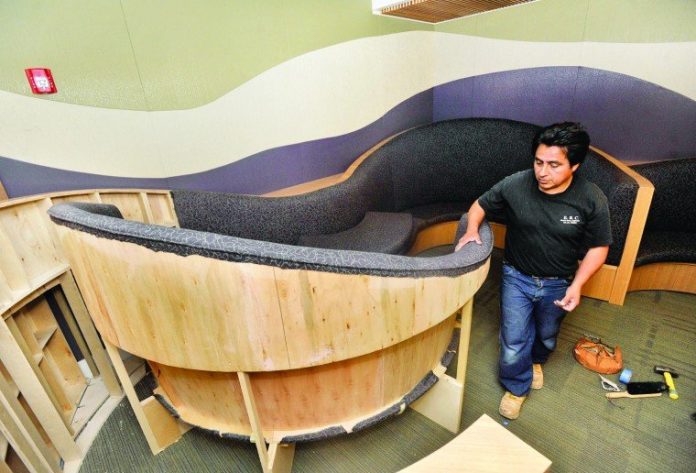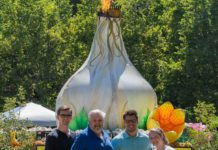
Unlike San Francisco’s California Academy of Sciences – an architectural marvel widely revered for its 197,000-square-foot “living rooftop” adorned by a tapestry of native plant species – one of Gilroy’s most eco-friendly edifices doesn’t outwardly flaunt its environmental virtue.
The Garlic Capital’s greenest building, in fact, is the color of khaki pants.
But, much in the way of Chevy Volts, Energy Star-rated refrigerators or water–powered alarm clocks, the inner-workings of Gilroy’s newest literacy lair is the stuff of environmental righteousness.
David Richards, the project manager in charge and principal with the 104-year-old national architect firm Harley, Ellis & Devereaux that designed the “Tree City USA” themed library, said his favorite feature is the building’s “relationship with the outdoors.”
Richards knows a thing or two about dreaming up tree-hugger-approved structures. Harley, Ellis & Devereaux is currently working on a “net zero” library in Berkeley, meaning it will eventually produce enough of its own energy to offset the energy it uses.
Patrons who curl up in one of the Gilroy library’s lime–hued lounge chairs for hours of relaxed reading can appreciate the building’s automated system of mixed mode ventilation. Fewer than 10 percent of California’s buildings have this snazzy temperature control feature, according to Richards.
Pointing to a gizmo with multiple antennas as he led a tour group along the library’s roof, City of Gilroy Public Information Officer Joe Kline said the apparatus employs a computerized weather station that regulates the building’s air conditioning, heating and windows, which are powered by electric motors.
Using the mixed mode approach should enable the library to operate its mechanical systems at 70 percent less than it normally would during operating hours, Richards noted.
A weatherized-thermostat isn’t the only feature that will make the environmentally conscious swoon, however.
Students who sprawl out at one of the many spacious tables for hours of uninterrupted study time will plug their laptops into outlets powered by 4,400 square feet of solar panels, which will supply the library with an average 21 percent of its annual power needs.
Suzanne Collins fans hunting for the last copy of “The Hunger Games” might notice a secondary motion sensor light that flips on when they approach any bookshelf – a special two-stage lighting system that illuminates the stacks when people are around – but otherwise employs minimal light usage, Kline explained. Vast windows that seemingly take up entire walls, along with special “light tubes” funneling natural sunlight from the roof into the building, mitigate the need to flip on every single light switch. Exterior walls consisting of 12-inch thick concrete provide solid insulation. Permeable pavers surrounding the library absorb rain runoff, directing it back into the natural water table as opposed to storm drains.
And heavens, however do those library clerks and volunteers who jog or ride their bikes to work still look so fresh and fabulous?
“We welcome a shower,” grinned Head Librarian Lani Yoshimura during a recent tour of the staff locker room.
If the 20-foot, fire engine red bike rack (playfully designed to resemble a giant bicycle) near the library’s entryway isn’t an obvious encouragement for staff to ditch the car and opt for a transportation mode with a smaller carbon footprint, installing showers in the break room ensures they won’t have to worry about smelling like a dirty gym sock for the rest of the day.
The old library built in 1975 (formerly located in the same spot as the new library) wasn’t thrown out with the bathwater either. Kline said 80 percent of the 12,500-square-foot building was recycled, with 91 percent of the demolished materials ultimately diverted from a landfill.
Richards anticipates the new library will receive a Leadership in Energy and Environmental Design Gold certification after it goes through a one-year certification period. As gold is the second highest of the four LEED categories, “almost nothing gets platinum,” noted Richards. “It’s pretty difficult.”
Awarded by an independent, third party, a LEED certification is the ultimate “bragging right” in the world of green building. This badge of honor denotes high performances in sustainable site development, water savings, energy efficiency, materials selection and indoor environmental quality.
In other words, a LEED certification will make Mother Nature very proud.











